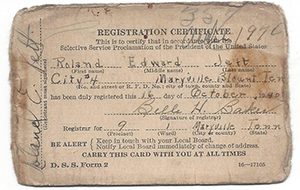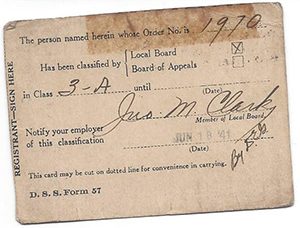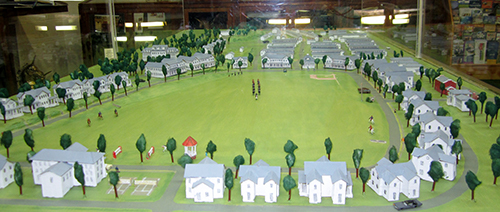Fort Oglethorpe, Georgia

The Importance of WWII Letters
August 2, 2016
Honoring Our Veterans at Anthem Veteran’s Memorial
November 22, 2016What do you know about your father’s enlistment in the service? Do you know where, when and what were the circumstances surrounding his enlistment? Perhaps you have a few clues about his draft status, but more likely, you may not know anything about his entry into WWII. This was true for me…I did not have any information about my father’s first steps into the WWII history books. It was only when I began reading my mother’s diary and going through her personal effects that I learned about the draft and my Dad’s enlistment.
Her remarks about his enlistment, however were few and the details sparse. After all it was a 5 year diary with limited space and just enough room for a couple of sentences to memorialize the day. In fact, on September 16, she made no mention of the Selective Service and Training Act of 1940, which was signed into law by President Franklin Roosevelt that very day. This new Act required all male citizens between the ages of 26 and 35 to register for the military draft and Rol Jett at age 32 was part of that group. However, she did acknowledge “Registration Day” in her October 16, 1940 entry. She also wrote that it was declared a national holiday and that she and her friend, Tate helped with the registration process in Negro Town. Initially this draft only impacted men, ages 26-35 and required a 12-month service commitment. But in the summer of 1941, Roosevelt asked Congress to extend the tour of duty an additional 18 months for a total of 30 months and required all men ages 18-65 to register.
Even through Rol was impacted by several key draft related activities; Virginia made no mention of them. Of significance was Wednesday October 16, 1940, when he joined 16 million other men who also registered that day. They each received an official registration certificate that had to be with them at all times. Then 9 months later, on June 18, 1941 he received his draft card. He was classified as 3-A which meant that he was not engaged in work essential to national defense and his draft number was 1970. This draft status was not a concern for either of them until December 7, 1941. With the bombing of Pearl Harbor and the United States declaring war on Japan the next day, Rol’s classification and draft number became much more significant.


These developments at Pearl Harbor threw the country directly into the war and the U.S. could no longer maintain its previous isolationist position. American families were also facing the inevitable reality that their lives and plans would be impacted as well. This was especially true for Rol and his fiancée who had planned on getting married the end of March. Those plans were cancelled and on February 10, 1942, Rol received his Selective Service notice to appear for a physical examination in two short days at 1 p.m. Quickly their future changed when he learned that he had to report for duty at Fort Oglethorpe, Georgia, two weeks later on February 26. That next day he was sworn into the U.S. Army as a Private First Class.
Like my father’s enlistment, I knew nothing about Fort Oglethorpe, Georgia…its location, history or role as an induction center for WWII. However, as part of my journey to tell my parent’s story, I wanted to visit as many places that my father’s Army service had taken him. So Fort Oglethorpe was an easy first choice. Not only was it just 117 miles from our home town, it was indeed the beginning of my father’s WWII story. So in the fall of 2014, I traveled there for several days of exploration.
Here’s what I learned. Fort Oglethorpe is just across the state line from Chattanooga, Tennessee, and it has a rich military history. Its early beginnings go back to 1898 when it served as a training ground for troops in the Spanish American war. Later it was expanded to provide additional space for instruction and training maneuvers and officially became an Army post in 1902. In July 1919, the 6th Cavalry was permanently assigned to the post and stayed there until 1942 when they left to fight in North Africa. During WWII, it was a training site for several other units including medics, doctors and even Capt. Dwight D. Eisenhower taught trench warfare there. Another unique aspect of the Fort was its role in developing and testing mechanized vehicles for use in combat. The scout car, the motorcycle and the bantam car, a predecessor to the jeep, were all field tested there.

In WWII it served many other significant functions as well. Not only was it a key Army induction center, but it also became a POW center for 3400 German prisoners who were captured overseas and brought to the US. At the end of the war, it served as a discharge center. But one of its most notable roles was that it became a major training base for women service members. In January of 1943, the first group of the Women’s Auxiliary Army Corps WAAC came to the Fort and then in July, President Roosevelt signed legislation creating the WAC, Women Army Corps. Eventually over 50,000 WACs were trained there prior to their assignments at other U.S. bases or their overseas.
It was against this historic backdrop that my father began his military service and I got to walk those grounds where he made his promise to fight for and defend his country. At the Fort Oglethorpe 6th Cavalry Museum, I also saw a 1940 replica of the Fort and imagined what it had looked like to him and his fellow recruits when they arrived. As I walked outside and passed by several still standing structures- the bandstand, the guardhouse, the field officers’ quarters, I wished he had been there to give me a personal tour. I wanted him to fill in the details of that first week in the Army…what did they do, did he know any of the other recruits and what was his biggest concern? I was filled with such strong emotions and so many questions. Slowly I breathed in that refreshing fall air and felt his presence there that day. I was just grateful that I had been able to walk for a brief moment where he had marched, stood at attention and prepared to serve his country in his new Army boots.

